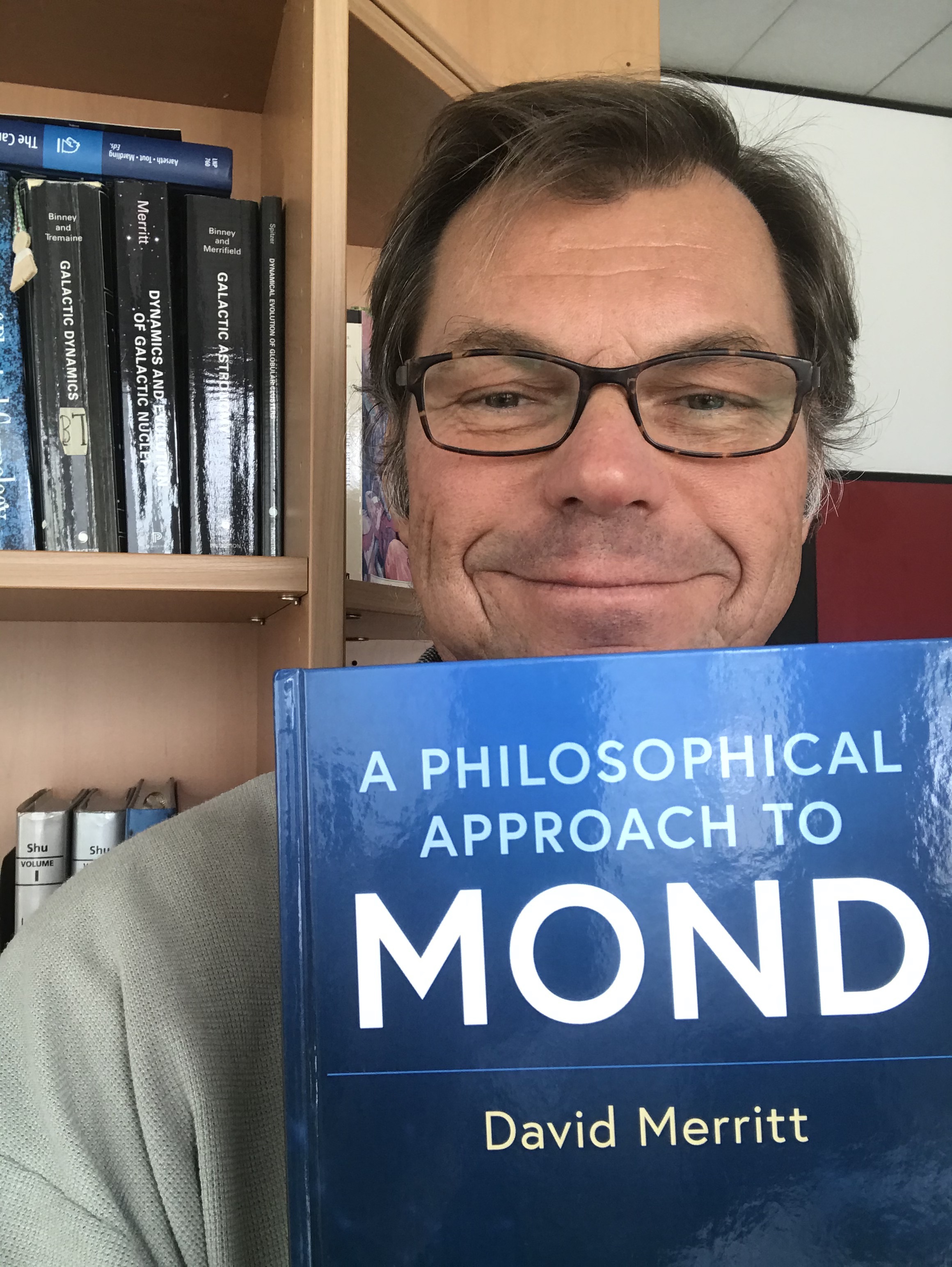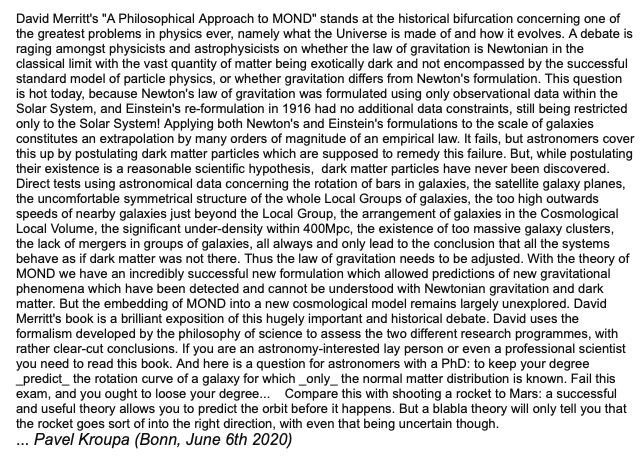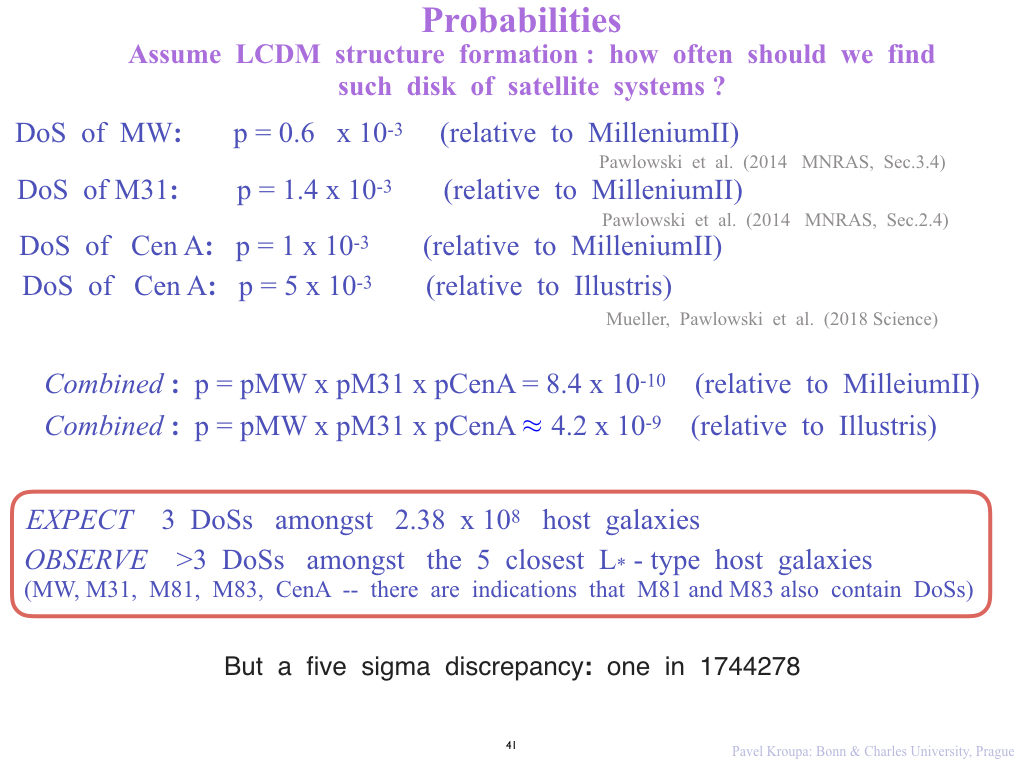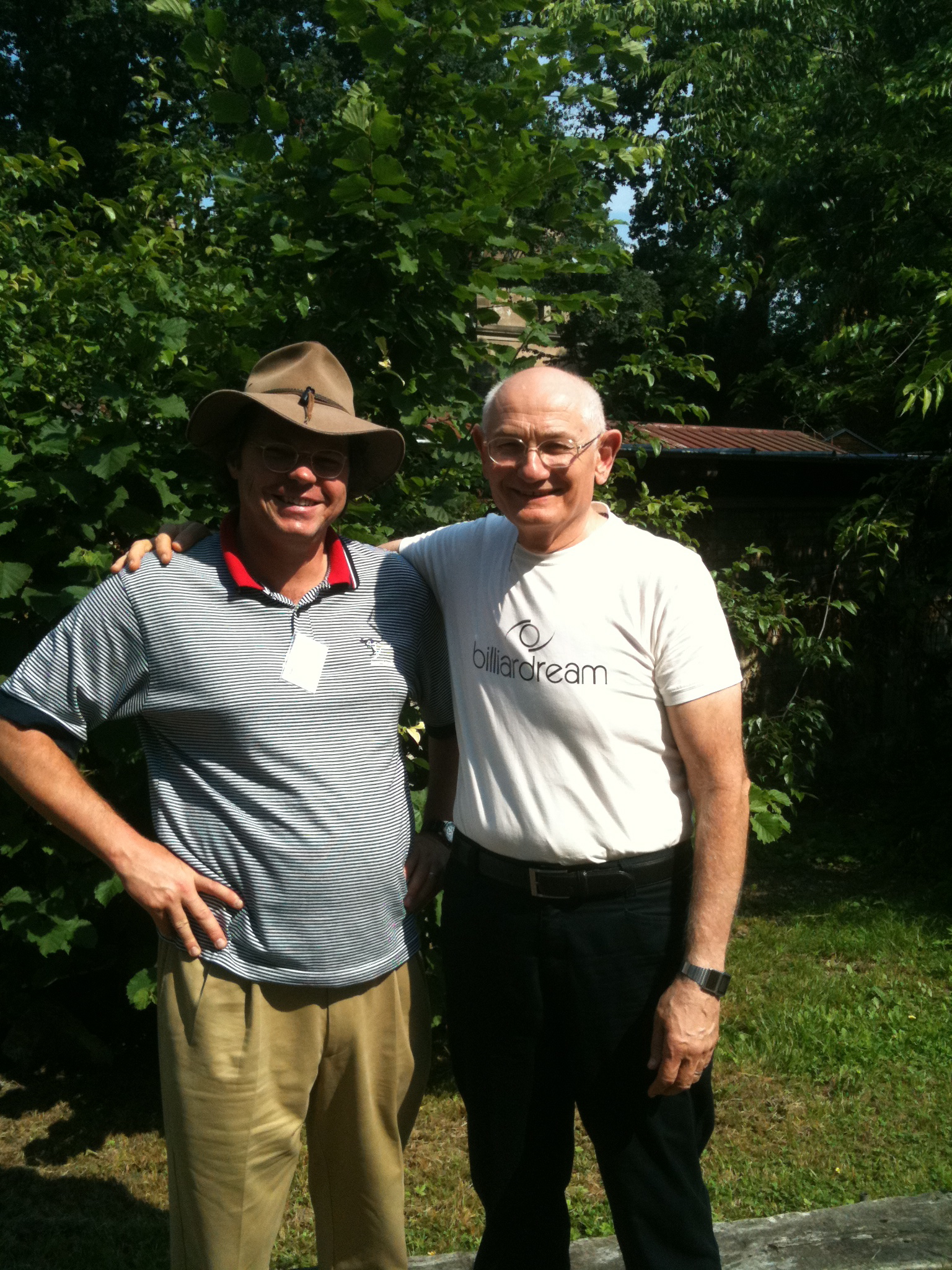Further on this matter:
"Navigating the landscape of fiendish behaviour, funding constraints and the desire to better understand the mechanisms of the Universe, in view of most probably very wide-spread mis-conceptions, is very hard. In the end one's own inquisitiveness, perseverance and elan may lead one to move forward satisfactorily, at least in one's own eyes" (PK, July 4th, 2020, in a letter to Vesselin Gueorguiev).
A piece on Aeon: Has dogma derailed the scientific search for dark matter?(Aeon, 25th Nov. 2016)
Definition of opinion : A view or judgement formed about something, not necessarily based on fact or knowledge. (from Oxford Living Dictionaries). Thus a scientist must not have an opinion, only inferences based on assumptions and data and a logical procedure to connect the two.
I received David Merrit's award winning ''A Philosophical Approach to MOND '', Cambridge University Press, in my office in Bonn on June 3rd, 2020:


"Nearly every one tries to dismiss MOND as being only phenomenological. I think this is wrong. MOND is not a phenomenological model but is a formulation based on a Lagrangian generalised (by Bekenstein & Milgrom 1984 ) from the standard Newtonian one, the generalisation being motivated by data which includes the Solar System as well as galaxies, while Newton's uses only Solar System data. Newton is just as phenomenological as Milgrom, and Einstein packaged Newton's findings into a sophisticated mathematical language, which may or may not be the correct physical description (arguably, it passes all tests when a > a_0). The very vast majority of the Universe is Milgromian! The Newtonian/Einsteinian regimes are only tiiiny bubbles in a huge expanse of scale-invariant dynamics as formulated by Milgrom." (email to Stacy McGaugh by PK on 16th Jan. 20201 after his Golden Webinar)
Large galaxies like our Milky Way form, in particle-dark-matter cosmological models (such as e.g. in the standard LCDM or warm-dark-matter or self-interacting dark-matter models), from a very large number of mergers, because the dark matter halos, when they interact, dissipate kinetic energy and merge. The satellite galaxies are a fossil remnant of this merger history, and the LCDM theory makes very clear predictions as to the phase-space distribution of these fossils. Is this phase-space distribution evident in the observed satellite galaxies?
This cosmological test was pioneered in 2005 with this publication: The great disk of Milky-Way satellites and cosmological sub-structures (Kroupa, Theis & Boily, 2005, MNRAS), and confirmed in The Milky Way's Disk of Classical Satellite Galaxies in Light of Gaia DR2 (Pawlowski & Kroupa, 2019, MNRAS). Using this test it was significantly clear that LCDM structure formation cannot account for the observed correlated phase-space distribution of satellite galaxies around the Milky Way, nor around Andromeda ( Ibata et al. 2013, Nature ).
With the discovery of a nearby third disk-of-satellite system [A whirling plane of satellite galaxies around Centaurus A challenges cold dark matter cosmology (Mueller, Pawlowski, Jerjen & Lelli 2018, Science)] the answer is now robust:
Assuming structure formation occurs according to the LCDM model, we expect 3 occurrences of Disk-of-Satellite (or satellite plane) systems amongst 2.4 hundred million MW-type galaxies. Instead, we observe more than three amongst the five nearest. This consitutes a discrepancy of more than 5sigma between observation and LCDM theory:

An important review is available: The Planes of Satellite Galaxies Problem, Suggested Solutions, and Open Questions (Pawlowski, 2018, MPLA).
The fossils of the putative merger history are thus not observed, and structures form differently than in the standard dark-matter models. This is supported by the result that rotation curves of many galaxies cannot be reproduced in the standard dark-matter models unless stars have negative masses, Rotation curves of galaxies and the stellar mass-to-light ratio (Haghi et al. 2018, MNRAS). Basically, in many observed galaxies, the standard dark-matter content is always too high, and mass then needs to be cancelled away in order to reproduce the observed rotation curves. Since baryonic matter is not well understood (or so is usually said), we can speculate that stars can have negative masses to achieve good fits of the observed rotation curves given the well-understood dark-matter halos. Clearly this is an unphysical conclusion.
In consequence, because dark matter does not exist, dynamical friction will neither be evident in the observed satellite motions nor in the dynamics of compact groups of galaxies. These tests have been performed: Using dwarf satellite proper motions to determine their origin (Angus, Diaferio & Kroupa, 2011, MNRAS) and Constraints on the dynamical evolution of the galaxy group M81 (Oehm, Thies & Kroupa, 2017, MNRAS). In the LCDM model, each observed galaxy has a halo made of dark matter particles around it which is about 50-few100 times more massive and about 20 times larger than the actually seen galaxy. These dark matter halos exert a strong breaking force (the "Chandrasekhar dynamical friction") and dissipate their kinetic energy as they move through each other. This breaking-effect is not seen in the motions of galaxies.
Thus, taken all the arguments together, the existence of dark matter particles is beasically excluded with extremely high confidence. Such falsifications are an essential procedure in the natural sciences in order to achieve efficient and rapid progress in an undersanding of our world. Sticking to a defunct theory halts advance.
Moving ahead, possible solutions to the disk-of-satellites problem are being studied: MOND simulation suggests the origin of some peculiarities in the Local Group (Bilek, Thies, Kroupa & Famaey, 2018, A&A) and Origin of the Local Group satellite planes in Modified Newtonian Dynamics (Banik, O'Ryan & Zhao, 2018, MNRAS).
Dark Matter Problems, Cosmology and Progress: a personal account
Falsification of the dark-matter hypothesis:
Local-Group tests of dark-matter concordance cosmology. Towards a new paradigm for structure formation y [Kroupa et al., 2010],
The Dark Matter Crisis: Falsification of the Current Standard Model of Cosmology [Kroupa, 2012],
Lessons from the Local Group (and beyond) on dark matter [Kroupa, 2014],
Galaxies as simple dynamical systems: observational data disfavor dark matter and stochastic star formation [Kroupa, 2015].
The observed spatial distribution of matter on scales ranging from 100kpc to 1Gpc is inconsistent with the standard dark-matter-based cosmological models [Kroupa, 2016].
Falsification of the dark-matter hypothesis on You Tube:
(in Czech) Prague Joint Colloquium with Dr. Michal Krizek: 29th Nov. 2017 Pavel Kroupa - 2x10 argumentu proti existenci zahadna temne hmoty - 1. cast (KS CAS 29.11.2017) .Heidelberg Joint Colloquium: 12th Nov. 2013 The vast polar structures around the Milky Way and Andromeda, and the implications thereof for fundamental physics.
Bethe Colloquium: Dark Matter - a Debate between Pavel Kroupa and Simon White at the Bethe Forum of the University of Bonn on 18th Nov. 2010:
The two presentations.
The debate .
The final debate afterwards .
[But I also research other problems, for example the formation and evolution of star clusters: an interview in Grenada, Spain .]
Phantom of Ramses (PoR) code for galaxy formation and evolution in Milgromian dynamics/MOND:
With a small grant from the Rectorate of the University of Bonn PK received in 2013, Fabian Lueghausen (in collaboration with Benoit Famaey and Pavel Kroupa) was able to develop in 2014 and 2015 a patch to Romain Teyssier's RAMSES code to allow dark-matter-free high-resolution simulations of galaxy formation and evolution.The Lueghausen, Famaey & Kroupa 2015 Phantom of Ramses (PoR) code is a patch to RAMSES. By default the patch comes with the RAMSES code whenever it is downloaded.
Independently of PoR, Candlish, Smith & Fellhauer (2015) developed RAYMOND which is also a RAMSES-based Milgromian-dynamics simulation code.
Wrong claims that standard-cosmological LCDM models can account for the observed satellite distributions:
Maji, Zhu, Marinacci & Li (2017a) and Maji, Zhu, Marinacci & Li (2017b) claim that the Disk of Satellites (DoS) around the Milky Way may be a misrepresentation of the data. These two manuscripts are based on false historical claims, procedural errors and incorrect treatment of data, as shown by Pawlowski et al. 2017.The Bahl & Baumgardt 2014 claim that the Andromeda great plane of satellites readily occurs in LCDM models is wrong, as shown by Ibata et al. 2014 and by Pawlowski et al. 2014 , who also discuss two other recent flawed claims that the observed satellite populations are consistent with LCDM models.
The Cautun, Wang, Frenk & Sawala 2015 claim that the anti-correlation of satellite galaxies observed around many host galaxies (discovered by Ibata et al. 2014) does not exist is wrong, as shown by Ibata et al. 2015.
Close scrutiny of such claims made by the standard-cosmology teams have until now always yielded flaws in the applied analysis. Noteworthy is that some of these claims (notably Maji et al.) are published on the arXiv before being refereed. With false claims being made, these authors appear to purposefully distort the scientific process. This damages science, because many readers do not have the knowledge of the subject, rely on the statements made by the authors, and the rigorous mathematical details may often be too involved for quick understanding.
Is this behaviour a result of over-motivation to demonstrate that LCDM works? Is it a desire to appear main-stream in the competition for funds, or for vying for some employment possibility? If this strategy works, then this part of the cosmological community has a serious problem in remaining to be viewed as a scientific establishment.
David Merritt provides a critical discussion of the present-day status of cosmological research in "Cosmology and Convention" ( Merritt, 2017). This situation in cosmology is part of a very major problem in fundamental physics research as elaborated in "The trouble with physics" by Lee Smolin 2006.
In the above Ibata et al. 2015 rebuttal, the authors write in their abstract: "All these unexpected correlations strongly suggest that a substantial fraction of satellite galaxies are causally-linked in their formation and evolution.", in agreement with the conclusions reached independently elsewhere that most, if not all, dSph and UFD satellites are old tidal dwarf galaxies without particle dark matter (2012a, 2012b and 2015; see also 1997).
Links to some of my relevant research papers and the German "Spektrum der Wissenschaft" article (free of charge, "kostenfrei"):
- Galaxies as simple dynamical systems: observational data disfavor dark matter and stochastic star formation (Kroupa, 2015, Canadian Journal of Physics). (free-of-charge pre-print)
- Lessons from the Local Group (and beyond) on dark matter (Kroupa, 2014, Dordrecht: Springer).
- The Failures of the Standard Model of Cosmology Require a New Paradigm (Kroupa, Pawlowski & Milgrom, 2012, International Journal of Modern Physics D, Volume 21, Issue 14, id. 1230003). (free-of-charge pre-print)
- The dark matter crisis: falsification of the current standard model of cosmology (Kroupa, 2012, Publications of the Astronomical Society of Australia, open access article - downloadable free of charge). (free-of-charge pre-print)
- Local-Group tests of dark-matter Concordance Cosmology: Towards a new paradigm for structure formation (Kroupa, Famaey, de Boer, Dabringhausen, Pawlowski, Boily, Jerjen, Forbes, Hensler, Metz, 2010, Astronomy and Astrophysics 523, 32) (free-of-charge pre-print)
- Das kosmologische Standardmodell auf dem Pruefstand (Kroupa & Pawlowski, August 2010, Spektrum der Wissenschaft)
Links to related Nature, Science and a few other papers dealing with issues relevant to the Dark Matter Problem:
-
A whirling plane of satellite galaxies around Centaurus A challenges cold dark matter cosmology
(Mueller et al., 2018, Science)
-
Eppur si muove: Positional and kinematic correlations of satellite pairs in the low Z universe
(Ibata et al., 2015, ApJ)
(free-of-charge pre-print) -
Velocity anti-correlation of diametrically opposed galaxy satellites in the low-redshift Universe
(Ibata et al., 2014, Nature)
(free-of-charge pre-print) -
Co-orbiting satellite galaxy structures are still in conflict with the
distribution of primordial dwarf galaxies
(Pawlowski et al., 2014, MNRAS)
(free-of-charge pre-print) -
Dwarf galaxy planes: the discovery of symmetric structures in the Local Group
(Pawlowski, Kroupa & Jerjen, 2013, MNRAS)
(free-of-charge pre-print) -
A vast, thin plane of corotating dwarf galaxies orbiting the Andromeda galaxy
(Ibata, Lewis, Conn, Irwin et al., 2013, Nature)
(free-of-charge pre-print) -
A structure in the early universe at z ~ 1.3 that exceeds the
homogeneity scale of the R-W concordance cosmology
(Clowes, Harris, Raghunathan et al., 2013, MNRAS)
(free-of-charge pre-print) -
Missing dark matter in the local universe
(Karachentsev, I.D., 2012, AstBu)
(free-of-charge pre-print) -
Nearby galaxies as pointers to a better theory of cosmic evolution
(Peebles & Nusser, 2010, Nature 465, 565)
(free-of-charge pre-print) -
Galaxies appear simpler than expected
(Disney, Romano, Garcia-Appadoo, West, Dalcanton, Cortese, 2008, Nature 455, 1082)
(free-of-charge pre-print)
Links to reviews on Milgromian dynamics/MOND:
- A tale of two paradigms: the mutual incommensurability of LCDM and MOND (McGaugh, 2015, Canadian Journal of Physics, Vol.93, pp.250-259). (arXiv)
- The "Missing Mass Problem" in Astronomy and the Need for a Modified Law of Gravity (Trippe, 2015, Zeitschrift fuer Naturforschung A, Vol.69, pp.173-187). (arXiv)
- The Third Law of Galactic Rotation (McGaugh, 2014, Galaxies, Vo.2, pp.601-622). (arXiv)
- The MOND paradigm of modified dynamics (Milgrom, 2013, Scholarpedia).
- Modified Newtonian Dynamics: A Review (Famaey & McGaugh, 2012, Living Reviews in Relativity). (free-of-charge pre-print)
- Modified Newtonian Dynamics: A Falsification of Cold Dark Matter (Sanders, 2009, Advances in Astronomy, article id 752439). (free-of-charge)
- A letter by Milgrom to Bahcall at Princeton dated April 1982 Here Milgrom already presents a discussion on issues such as the inability to falsify dark matter (called "hidden matter" then) in Newtonian dynamics versus the predictability of the formula he was discovering.
Prof. Dr. Pavel Kroupa (University of Bonn; https://www.astro.uni-bonn.de/~pavel/ )
Mordehai Milgrom and Pavel Kroupa at BonnGravity2019, Bonn, 24.09.2019.

Pavel Kroupa and Mordehai Milgrom at MGADS, Strasbourg, 29.06.2010.